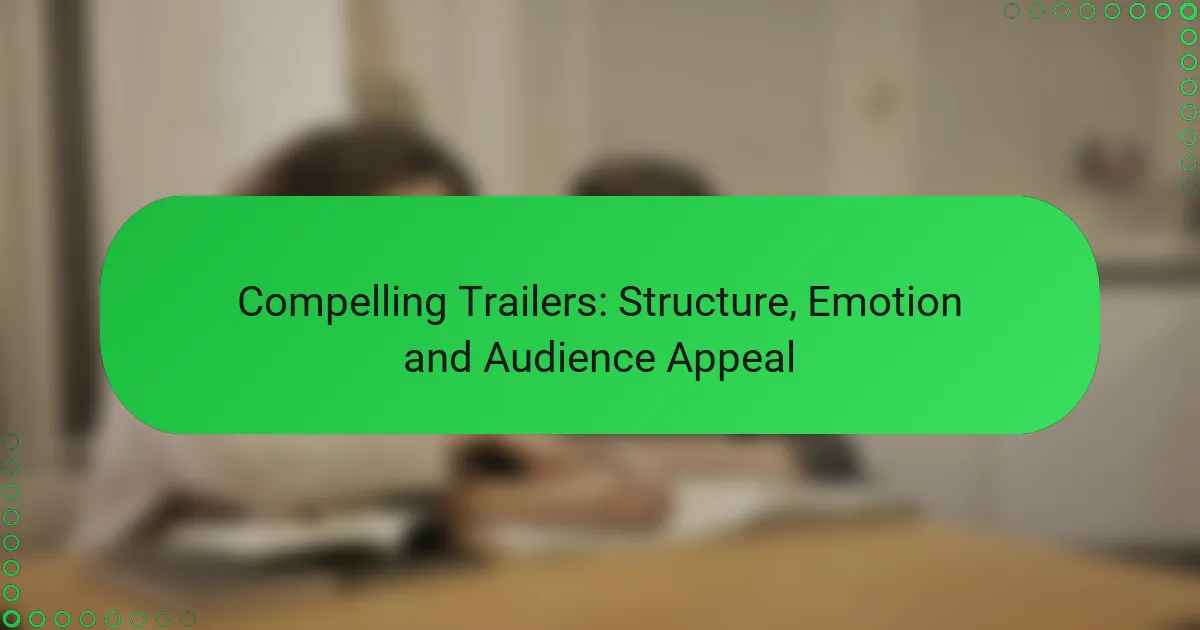A compelling trailer is essential for capturing audience interest and conveying the essence of a film or product. By following a structured format that builds anticipation and emotional connection, trailers evoke excitement and curiosity, compelling viewers to seek out the full experience. Understanding the target audience’s preferences and emotional triggers further enhances the trailer’s effectiveness, ensuring it resonates deeply and drives engagement.

How to Structure a Compelling Trailer?
A compelling trailer is structured to engage the audience and convey the essence of the film or product. It typically follows a clear format that builds anticipation and emotional connection while highlighting key elements of the story.
Three-Act Structure
The three-act structure is a classic storytelling framework that can effectively guide trailer creation. In the first act, introduce the main characters and setting, establishing the stakes. The second act should present the central conflict or challenge, while the third act delivers a resolution or a cliffhanger that leaves viewers wanting more.
For example, a trailer for an action movie might start with a hero’s ordinary life, escalate to a significant threat, and conclude with a glimpse of the climactic showdown. This structure helps maintain narrative coherence and keeps the audience engaged.
Key Elements of a Trailer
Key elements of a trailer include captivating visuals, engaging dialogue, and a strong narrative hook. These components work together to create intrigue and excitement. Focus on showcasing the most compelling aspects of the story, such as unique characters, dramatic moments, or stunning visuals.
Consider using a mix of action sequences, emotional beats, and memorable quotes to create a well-rounded preview. Aim for a duration of about 1-3 minutes to keep the audience’s attention without revealing too much.
Effective Pacing Techniques
Pacing is crucial in a trailer to maintain viewer interest. Start with a slower pace to establish context, then gradually increase the tempo as the conflict intensifies. This shift can create a sense of urgency and excitement.
Use quick cuts and dynamic transitions to enhance the pacing. A good rule of thumb is to alternate between fast-paced action and slower, emotional moments to give the audience time to absorb the story while keeping them on the edge of their seats.
Visual Storytelling Strategies
Visual storytelling is essential in trailers, as images often convey emotions more powerfully than words. Use striking visuals that encapsulate the film’s tone and themes. For instance, vibrant colors can evoke excitement, while darker tones may suggest tension or drama.
Incorporate a variety of shots, such as close-ups to capture emotions and wide shots to establish settings. This combination helps create a dynamic viewing experience that draws the audience into the narrative.
Use of Sound and Music
Sound and music play a pivotal role in enhancing the emotional impact of a trailer. A well-chosen soundtrack can elevate the mood and reinforce the story’s themes. Consider using a mix of original scores and popular songs to resonate with the audience.
Sound effects are equally important; they can heighten tension or accentuate key moments. Ensure that the audio complements the visuals, creating a cohesive experience that leaves a lasting impression on viewers.

What Emotions Should a Trailer Evoke?
A compelling trailer should evoke a mix of excitement, curiosity, and emotional resonance. These emotions draw viewers in and create a strong desire to see the full film or show.
Building Anticipation
To build anticipation, a trailer should tease key plot points without revealing too much. Use quick cuts, intriguing visuals, and a captivating soundtrack to create a sense of urgency and excitement.
Consider employing a countdown or a release date reveal to heighten anticipation. This strategy can effectively engage audiences and encourage them to mark their calendars.
Creating Emotional Connections
Emotional connections are crucial for a trailer’s success. Highlight relatable characters and their struggles to foster empathy and investment from the audience.
Utilize poignant moments or powerful dialogue that resonate with viewers’ experiences. This approach can turn casual viewers into dedicated fans eager to see how the story unfolds.
Using Humor Effectively
Humor can lighten the mood and make a trailer memorable. Incorporate witty one-liners or funny situations that align with the film’s tone to engage viewers.
Balance humor with the overall emotional arc of the trailer; too much comedy can detract from the film’s serious elements. Aim for a mix that reflects the film’s genre and themes.
Incorporating Tension and Conflict
Introducing tension and conflict is essential for capturing attention. Show glimpses of challenges the characters face to create intrigue and suspense.
Use dramatic music and pacing to enhance the sense of urgency. Highlighting stakes can compel viewers to want to find out how conflicts are resolved, making them more likely to watch the full content.

How to Appeal to Your Target Audience?
To effectively appeal to your target audience, understand their preferences, demographics, and emotional triggers. Tailoring your trailer’s content to resonate with these factors can significantly enhance viewer engagement and interest.
Identifying Audience Demographics
Start by researching the age, gender, location, and interests of your potential viewers. This data helps in crafting a trailer that speaks directly to their experiences and expectations. For instance, a trailer aimed at teenagers may incorporate fast-paced editing and popular music, while one targeting older adults might focus on storytelling and character development.
Utilize tools like social media analytics and surveys to gather insights about your audience. Knowing whether your audience is predominantly male or female, or if they prefer action over romance, can guide your creative decisions.
Tailoring Content to Audience Preferences
Once you understand your audience demographics, customize your trailer’s content to align with their preferences. Highlight themes, genres, and visual styles that resonate with your target group. For example, if your audience enjoys thrillers, emphasize suspenseful moments and cliffhangers.
Consider the emotional tone as well; younger audiences might appreciate humor and excitement, while older viewers may prefer drama and depth. Use relatable characters and scenarios to create a connection that draws viewers in.
Using Feedback for Improvement
Gathering feedback from test screenings or focus groups can provide valuable insights into how your trailer is received. Pay attention to viewers’ reactions and comments to identify what works and what doesn’t. This iterative process allows you to refine your trailer before its final release.
Implement changes based on constructive criticism, such as adjusting pacing or altering key scenes. Engaging with your audience through social media can also yield informal feedback that helps you gauge their interests and preferences.
Analyzing Competitor Trailers
Study trailers from similar films or shows to understand what appeals to their audiences. Look for common elements in successful trailers, such as pacing, music choice, and emotional hooks. This analysis can reveal trends and effective strategies that you can adapt for your own project.
Additionally, identify gaps in competitors’ trailers that your content can fill. If competitors focus heavily on action but neglect character development, you might choose to highlight emotional stakes in your trailer, setting it apart in the marketplace.

What Are the Best Practices for Trailer Production?
Best practices for trailer production focus on effective storytelling, emotional engagement, and audience targeting. A well-crafted trailer should capture the essence of the film while enticing viewers to watch the full feature.
Utilizing Professional Editing Software
Using professional editing software is crucial for creating high-quality trailers. Programs like Adobe Premiere Pro or Final Cut Pro offer advanced features that allow for precise cuts, color grading, and sound design, which enhance the overall production value.
When selecting software, consider your team’s expertise and the specific needs of your project. A user-friendly interface may benefit smaller teams, while more complex tools can provide depth for larger productions.
Collaborating with Experienced Filmmakers
Collaboration with experienced filmmakers can significantly elevate the quality of a trailer. Their insights into pacing, shot selection, and narrative structure can help ensure that the trailer effectively conveys the film’s themes and tone.
Engaging a director or editor with a strong portfolio can also provide valuable networking opportunities and enhance the trailer’s visibility. Look for professionals who have a track record of successful trailers in your genre.
Incorporating Audience Testing
Incorporating audience testing is essential for gauging the trailer’s impact. By screening the trailer to a sample audience, you can gather feedback on emotional responses and overall appeal, which can inform any necessary adjustments.
Consider using focus groups or online surveys to collect data. Aim for a diverse audience to ensure broad appeal, and be open to making changes based on their insights to maximize engagement.

What Tools Can Enhance Trailer Creation?
Several tools can significantly improve the process of creating compelling trailers, focusing on editing capabilities, effects, and user experience. Choosing the right software depends on your specific needs, budget, and level of expertise.
Adobe Premiere Pro
Adobe Premiere Pro is a professional-grade video editing software widely used in the film industry. It offers a robust set of features, including multi-camera editing, advanced color correction, and a vast library of effects and transitions.
When using Premiere Pro, consider its integration with other Adobe products like After Effects and Photoshop for enhanced graphics and animations. However, the learning curve can be steep for beginners, so investing time in tutorials is advisable.
Final Cut Pro
Final Cut Pro is Apple’s flagship video editing software, known for its intuitive interface and powerful performance. It supports 4K video editing and provides advanced features like magnetic timeline and smart conform for efficient editing.
This tool is particularly favored by Mac users due to its seamless integration with the Apple ecosystem. While it may be pricier than some alternatives, its capabilities justify the investment for serious filmmakers.
Filmora Video Editor
Filmora Video Editor is a user-friendly option ideal for beginners and those on a budget. It offers a simple drag-and-drop interface, making it easy to create trailers without extensive editing knowledge.
With a range of built-in effects, transitions, and music options, Filmora allows users to produce visually appealing trailers quickly. However, it may lack some advanced features found in professional software, so assess your needs before choosing this tool.
